Abstract
Severe forms of paracoccidioidomycosis (Pcm) are accompanied by intense immunological involvement characterized by depression of the cell-mediated immune response and by high levels of antibodies in serum with no protective function. These changes can be reversed by antifungal treatment. It has been suggested that antigens of Paracoccidioides brasiliensis released into the circulation during the active phase of the disease may be involved in the genesis of the changes in the immune response. In the present study, we evaluated the antigenemia of patients with Pcm using a competitive enzyme-linked immunosorbent assay (ELISA-c) capable of detecting 6 ng of antigen per ml of serum. Twenty-seven of 88 serum samples tested gave positive results, with the highest frequency of positivity being detected in patients with the severe acute form of the disease; these patients had the highest antigen levels (0.03 to 3.4 micrograms/ml). Follow-up of one case showed a correlation between antigen levels in serum and evolution of the disease. False-positive reactions were observed in sera from patients with histoplasmosis, aspergillosis, and cryptococcosis. The results indicate that the described method has potential for clinical application, especially with respect to the evaluation of disease activity. Quantification of fungal antigens in the serum of patients with active Pcm represents an objective parameter for the study of the physiopathology of the disease.
Full text
PDF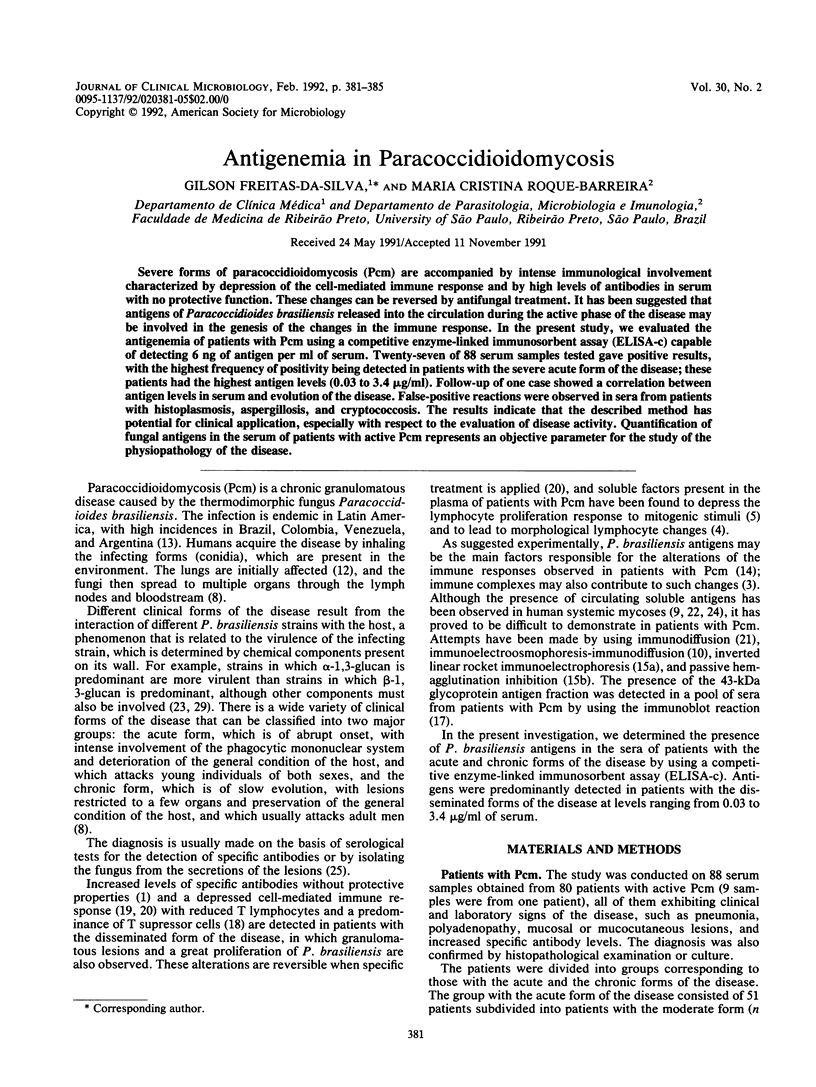
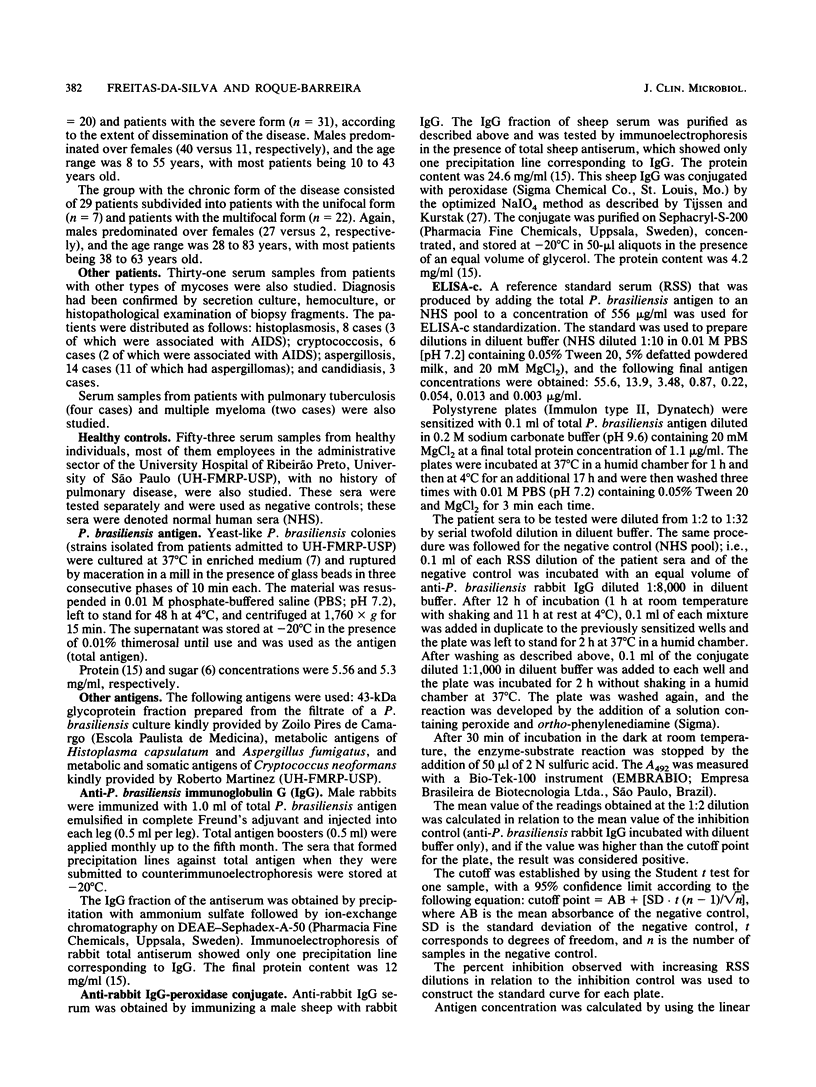
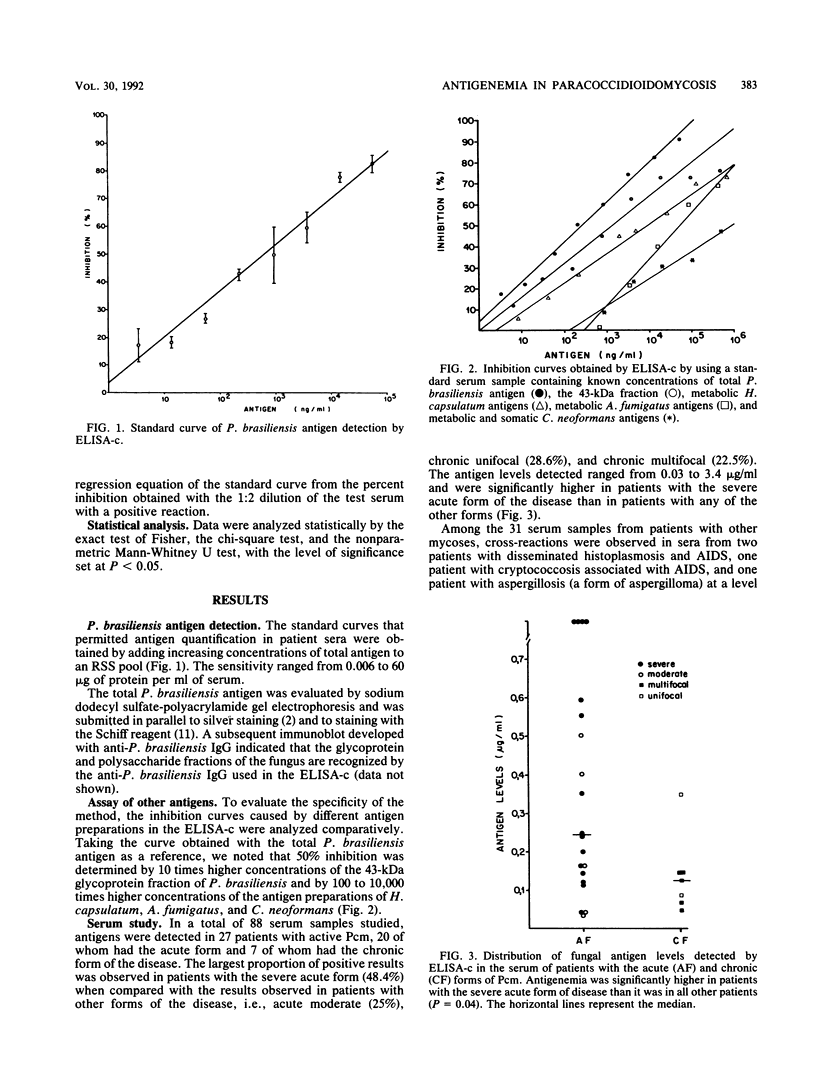
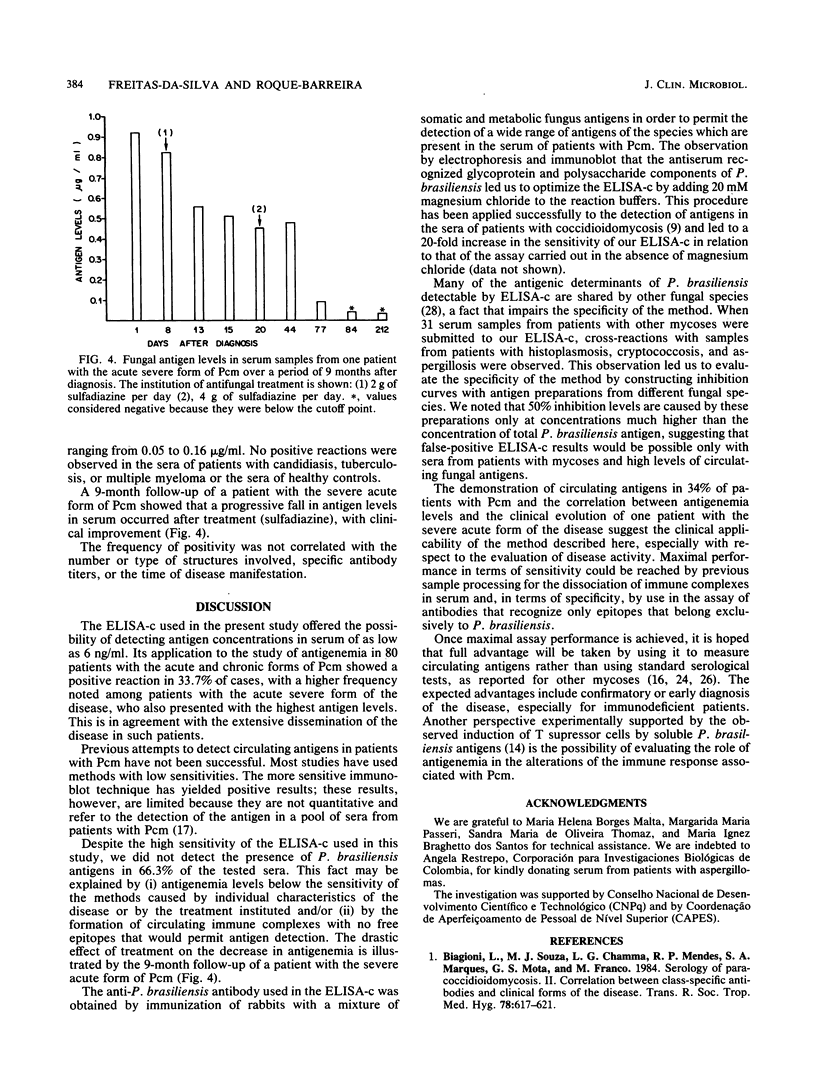
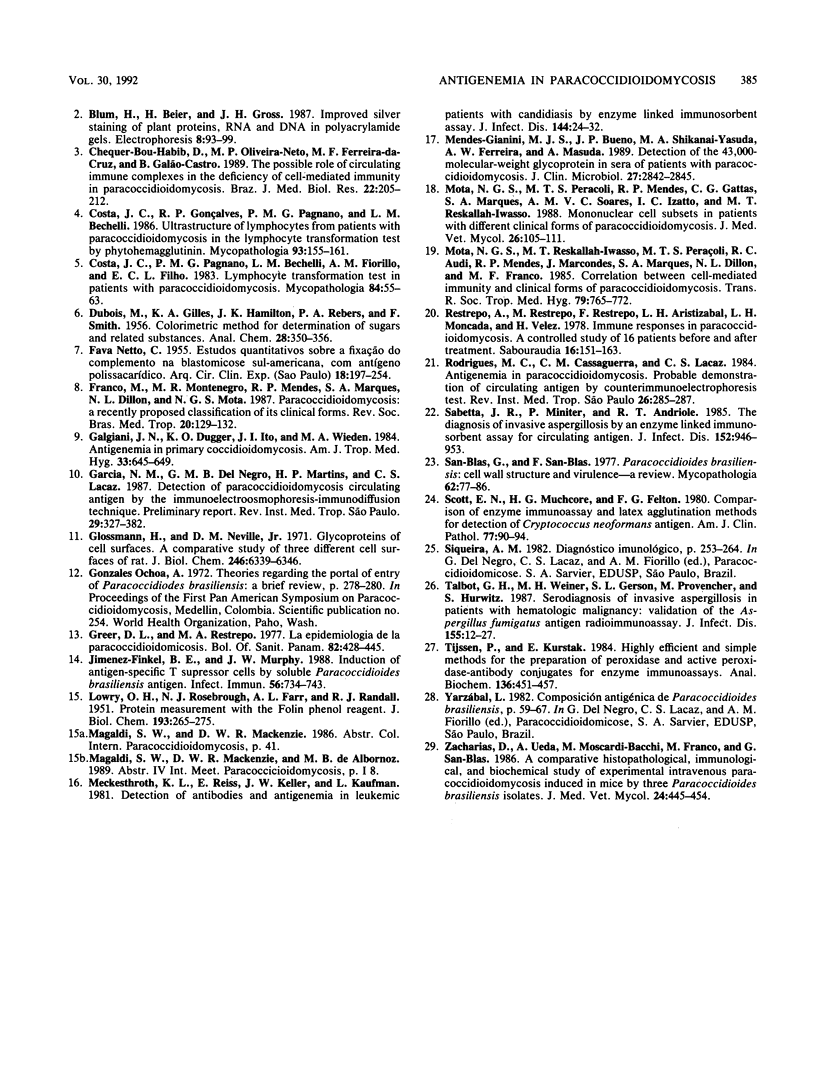
Selected References
These references are in PubMed. This may not be the complete list of references from this article.
- Biagioni L., Souza M. J., Chamma L. G., Mendes R. P., Marques S. A., Mota N. G., Franco M. Serology of paracoccidioidomycosis. II. Correlation between class-specific antibodies and clinical forms of the disease. Trans R Soc Trop Med Hyg. 1984;78(5):617–621. doi: 10.1016/0035-9203(84)90220-7. [DOI] [PubMed] [Google Scholar]
- Chequer-Bou-Habib D., Oliveira-Neto M. P., Ferreira-da-Cruz M. F., Galvão-Castro B. The possible role of circulating immune complexes in the deficiency of cell-mediated immunity in paracoccidioidomycosis. Braz J Med Biol Res. 1989;22(2):205–212. [PubMed] [Google Scholar]
- Da Costa J. C., Conçalves R. P., Pagnano P. M., Bechelli L. M. Ultrastructure of lymphocytes from patients with paracoccidioidomycosis in the lymphocyte transformation test by phytohemagglutinin. Mycopathologia. 1986 Mar;93(3):155–161. doi: 10.1007/BF00443518. [DOI] [PubMed] [Google Scholar]
- Da Costa J. C., Pagnano P. M., Bechelli L. M., Fiorillo A. M., de Lima Filho E. C. Lymphocyte transformation test in patients with paracoccidioidomycosis. Mycopathologia. 1983 Dec 1;84(1):55–63. doi: 10.1007/BF00436998. [DOI] [PubMed] [Google Scholar]
- Franco M., Montenegro M. R., Mendes R. P., Marques S. A., Dillon N. L., Mota N. G. Paracoccidioidomycosis: a recently proposed classification of its clinical forms. Rev Soc Bras Med Trop. 1987 Apr-Jun;20(2):129–132. doi: 10.1590/s0037-86821987000200012. [DOI] [PubMed] [Google Scholar]
- Galgiani J. N., Dugger K. O., Ito J. I., Wieden M. A. Antigenemia in primary coccidioidomycosis. Am J Trop Med Hyg. 1984 Jul;33(4):645–649. doi: 10.4269/ajtmh.1984.33.645. [DOI] [PubMed] [Google Scholar]
- Garcia N. M., Del Negro G. M., Martins H. P., Lacaz C. da S. Detection of paracoccidioidomycosis circulating antigen by the immunoelectroosmophoresis-immunodiffusion technique. Preliminary report. Rev Inst Med Trop Sao Paulo. 1987 Sep-Oct;29(5):327–328. doi: 10.1590/s0036-46651987000500011. [DOI] [PubMed] [Google Scholar]
- Glossmann H., Neville D. M., Jr Glycoproteins of cell surfaces. A comparative study of three different cell surfaces of the rat. J Biol Chem. 1971 Oct 25;246(20):6339–6346. [PubMed] [Google Scholar]
- Jimenez-Finkel B. E., Murphy J. W. Induction of antigen-specific T suppressor cells by soluble Paracoccidioides brasiliensis antigen. Infect Immun. 1988 Apr;56(4):734–743. doi: 10.1128/iai.56.4.734-743.1988. [DOI] [PMC free article] [PubMed] [Google Scholar]
- LOWRY O. H., ROSEBROUGH N. J., FARR A. L., RANDALL R. J. Protein measurement with the Folin phenol reagent. J Biol Chem. 1951 Nov;193(1):265–275. [PubMed] [Google Scholar]
- Meckstroth K. L., Reiss E., Keller J. W., Kaufman L. Detection of antibodies and antigenemia in leukemic patients with candidiasis by enzyme-linked immunosorbent assay. J Infect Dis. 1981 Jul;144(1):24–32. doi: 10.1093/infdis/144.1.24. [DOI] [PubMed] [Google Scholar]
- Mendes-Giannini M. J., Bueno J. P., Shikanai-Yasuda M. A., Ferreira A. W., Masuda A. Detection of the 43,000-molecular-weight glycoprotein in sera of patients with paracoccidioidomycosis. J Clin Microbiol. 1989 Dec;27(12):2842–2845. doi: 10.1128/jcm.27.12.2842-2845.1989. [DOI] [PMC free article] [PubMed] [Google Scholar]
- Mota N. G., Peraçoli M. T., Mendes R. P., Gattass C. R., Marques S. A., Soares A. M., Izatto I. C., Rezkallah-Iwasso M. T. Mononuclear cell subsets in patients with different clinical forms of paracoccidioidomycosis. J Med Vet Mycol. 1988 Apr;26(2):105–111. doi: 10.1080/02681218880000151. [DOI] [PubMed] [Google Scholar]
- Mota N. G., Rezkallah-Iwasso M. T., Peraçoli M. T., Audi R. C., Mendes R. P., Marcondes J., Marques S. A., Dillon N. L., Franco M. F. Correlation between cell-mediated immunity and clinical forms of paracoccidioidomycosis. Trans R Soc Trop Med Hyg. 1985;79(6):765–772. doi: 10.1016/0035-9203(85)90112-9. [DOI] [PubMed] [Google Scholar]
- NETTO C. F. Estudos quantitativos sôbre a fixaço do complemento na blastomicose sul-americana, com antígeno polissacarídico. Arq Cir Clin Exp. 1955 Sep-Dec;18(5-6):197–254. [PubMed] [Google Scholar]
- Restrepo A., Restrepo M., de Restrepo F., Aristizábal L. H., Moncada L. H., Vélez H. Immune responses in paracoccidioidomycosis. A controlled study of 16 patients before and after treatment. Sabouraudia. 1978 Jun;16(2):151–163. [PubMed] [Google Scholar]
- Rodrigues M. C., Cassaguerra C. M., Lacaz C. da S. Antigenemia in paracoccidioidomycosis. Probable demonstration of circulating antigen by counterimmunoelectrophoresis test. Preliminary report. Rev Inst Med Trop Sao Paulo. 1984 Sep-Oct;26(5):285–287. doi: 10.1590/s0036-46651984000500011. [DOI] [PubMed] [Google Scholar]
- Sabetta J. R., Miniter P., Andriole V. T. The diagnosis of invasive aspergillosis by an enzyme-linked immunosorbent assay for circulating antigen. J Infect Dis. 1985 Nov;152(5):946–953. doi: 10.1093/infdis/152.5.946. [DOI] [PubMed] [Google Scholar]
- San-Blas G., San-Blas F. Paracoccidioides brasiliensis: cell wall structure and virulence. A review. Mycopathologia. 1977 Dec 16;62(2):77–86. doi: 10.1007/BF01259396. [DOI] [PubMed] [Google Scholar]
- Talbot G. H., Weiner M. H., Gerson S. L., Provencher M., Hurwitz S. Serodiagnosis of invasive aspergillosis in patients with hematologic malignancy: validation of the Aspergillus fumigatus antigen radioimmunoassay. J Infect Dis. 1987 Jan;155(1):12–27. doi: 10.1093/infdis/155.1.12. [DOI] [PubMed] [Google Scholar]
- Tijssen P., Kurstak E. Highly efficient and simple methods for the preparation of peroxidase and active peroxidase-antibody conjugates for enzyme immunoassays. Anal Biochem. 1984 Feb;136(2):451–457. doi: 10.1016/0003-2697(84)90243-4. [DOI] [PubMed] [Google Scholar]
- Zacharias D., Ueda A., Moscardi-Bacchi M., Franco M., San-Blas G. A comparative histopathological, immunological, and biochemical study of experimental intravenous paracoccidioidomycosis induced in mice by three Paracoccidioides brasiliensis isolates. J Med Vet Mycol. 1986 Dec;24(6):445–454. [PubMed] [Google Scholar]


